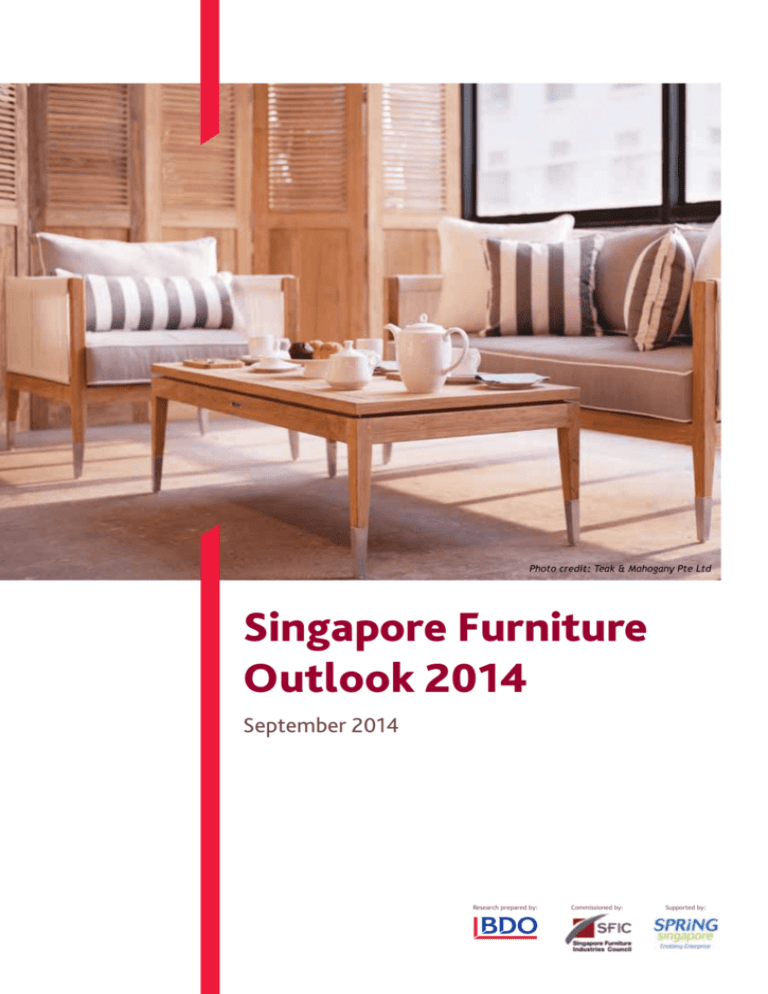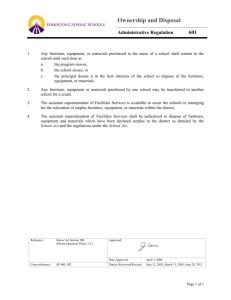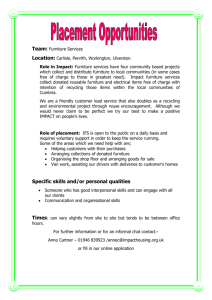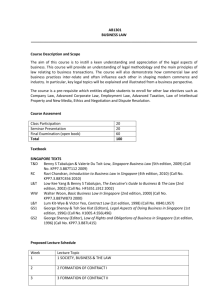
Photo credit: Teak & Mahogany Pte Ltd
Singapore Furniture
Outlook 2014
September 2014
Research prepared by:
Commissioned by:
Supported by:
CONTENTS
Overview........................................... 04
Internationalisation Trends............. 08
Productivity Measures...................... 12
Best Practices.....................................14
Local Challenges................................16
3i - The Way Forward........................18
ABOUT BDO SINGAPORE
At BDO Singapore we build our business on strong
personal relationships with our clients. Whether
you are a small start up, SME or large multinational
company, you can expect the same friendly,
personal and proactive service from our team of
professionals. We value each client as our business
partner. So whatever the size of your business, what
matters to you, matters to us.
ABOUT BDO INTERNATIONAL
Foreword
For over 30 years, the Singapore
furniture industry has adapted
and evolved rapidly to the
changes brought about by
broader
macroeconomic
changes. In response, the
industry
sought
further
internationalisation
and
automation as their solutions,
and have endured with amazing resilience throughout
these years.
However, we are now witnessing the onslaught of a new
era of doing business. To ensure the continued growth
and dynamism of the Singapore furniture industry, it is
integral for the Council to push forward with its newly
formulated 3i strategic framework – Improve, Innovate
and Integrate to actualize design-centric growth.
In view of this, the next 3 years will see further attempts
to adopt more innovation and design centric measures
within the furniture & furnishings industry. For that, I
hope to see a much stronger Singapore brand emerge as
we advance closer to our aim of establishing ourselves as
a premier regional hub, providing total solutions to the
global market.
Ernie Koh
President
Singapore Furniture Industries Council
Photo credit: Admira Pte Ltd
04 Singapore Furniture Outlook 2014
Overview
It has been a long way since the 2008 economic crisis
that threatened to cripple the financial stability of the
world. 5 years have passed and it seems that we are fast
coming to the first sight of global recovery in the coming
years.
The Annual Furniture Industry Survey 2013-14 is
spearheaded by both Singapore Furniture Industries
Council and SPRING Singapore and it is with great honor
that BDO Consultants Pte Ltd. has been selected to help
execute this round of surveys in 2013-14.
For one, Singapore has kept up well despite the global
turmoil and we have seen these translate into modest
growth in 2013. As reported by the Singapore Ministry
of Trade and Industry (MTI), “For the whole of 2013, the
Singapore economy expanded by 4.1 per cent, higher
than the 1.9 per cent growth in 2012.” Going forward,
the Singapore economic outlook is expected to continue
on its recovery, and is expected to have significant spillover effects into the furniture industry.
Contingent with the market conditions of 2013-14,
it is heartening to see that the furniture industry has
regained its growth momentum, with total furniture
trade amounting to an estimated S$6.01 billion for 2013,
and clocking a positive growth of 3.3% from 2012.
Going forward, industry players do expect this growth to
persist to reach a total trade value of S$6.34 billion by
2014, resulting in a cumulative growth of around 9% for
the period of 2012 to 2014.
Singapore Furniture Industry
Market Size (SGD)
6.34
billion
cumulative growth of around
9% for the period of 2012 to
2014
6.01
billion
5.82
billion
2012
(Verified)
2013
(Estimated)
2014
(Forecasted)
Singapore Furniture Outlook 2014
05
Where do we expect most growth to
come from?
Furniture Industry Market Size Breakdown
(2012-14) (SGD Mil)
107
69
61
1075
1083
1126
2133
2224
2415
808
778
1006
1598
1666
1660
2012
2013
Manufacturer
Contract
Manufacturer
Retailer
Wholesaler
Interestingly, amongst the various classifications that
were chosen to represent the furniture industry in
Singapore, designers are expected to possess the
greatest growth potential going forward (+75% by 2014).
2014
Designer
Contract manufacturers and retailers are expected to
contribute positive growth, whilst manufacturing and
wholesale sectors are expected to flat-line in the coming
period of 2014.
06 Singapore Furniture Outlook 2014
Singapore industry set to outpace
global counterparts
Despite the general positive outlook, it is cautioned
that the older years of dramatic growth are over. It
is interesting to note that the industry has performed
considerably well in the earlier years, with a year on
year growth rate of about 16% for the period 2010 – 11
and about 7.50% for the period 2011-12.
Industry players expect much more modest growth
within the Singapore furniture industry going forward.
Nevertheless, current expectations do still better global
averages projected, and it is affirmative to say that
there is considerable potential in the industry in the next
few years.
Singapore Growth vs.
Global Growth (%)
610
8%
7.50%
7
600
5.50%
590
6
5
580
4
3.20%
3.60%
570
2.60%
2.60%
2
560
550
3
1
569
584
605
2011-12
2012-13
2013-14
Global Furniture
Market Size
YOY Rates
Singapore
0
YOY Rates
Global
Source: Market Line April 2013: Report on the
Global Furniture and Floor Coverings
The Singapore Furniture Industry accounts for 1.08% of
the Global Furniture Markets
Photo credit: Commune Lifestyle
08 Singapore Furniture Outlook 2014
Internationalisation
Trends
B ig
d
Me
m ark et
iu m m a r k et
Sm
a ll m a r k e t
Country/Region
2013 share
(2012 share)
Top locations for
overseas expansions
Singapore Furniture Outlook 2014
Internationalisation has long been a focal feature of
Singaporean businesses; with a country measuring one
full marathon across and a half marathon from top to
bottom, the country offers limited expansion possibilities
domestically. In view of this, many furniture companies
have since sought their fortunes overseas.
09
Consistent with previous year findings, Malaysia and
China remain the top overseas locations for operations.
Industry players have long lamented the lack of access
to necessary resources, especially in seeking land and
necessary labor for production facilities in Singapore, and
have thereby relocated the majority of their productions
overseas.
10 Singapore Furniture Outlook 2014
In terms of reaching out to new markets through sales,
Myanmar and Indonesia remain popular choices this year.
Europe is clearly the most attractive region for Singapore
furniture businesses, and of those who cited Europe,
28% expressed particular interest in Germany. This was
followed by interest in the UK, which sat at 22%.
nesia
Indo
7%
re
po
ga
Sin 34%
s
er
th
8%
ina
Ch
%
20
Vietn
am
9%
O
In fact, many Singaporean businesses’ appetites for
internationalisation extends beyond merely leveraging
their production capabilities into cheaper regions of the
world. Amongst those surveyed in this round of surveys,
49% of the firms have expressed their intentions to
further their expansion overseas with much more focus
on establishing permanent operations such as sales
offices or physical outlets.
22%
M ala ys
49%
ia
Percentage of Manufacturing
Facilities in Respective Countries
have expansion plans in
the next 3 years
Intended Overseas Permanent Operations
to be Established in the Next 3 Years
1%
12%
38%
39%
Manufacturing
Sales Office
Retail Outlets
40
30
20
10
0
Headquarters
Singapore Furniture Outlook 2014
11
Where are the markets for future
growth?
As expected, the larger the business, the higher the
probability of having existent overseas operations. Of
the various existent overseas operations recorded,
85% belonged to Singapore furniture businesses with
a revenue of SGD 5 million and above. In fact, 44% of
these establishments belong specifically to firms with
revenues of SGD 20 to 79.9 million. It is apparent that
internationalisation is highly related to the business’s
size, and it scales up rapidly when firms reach the mark
of SGD 5 million and beyond.
Expected Overseas Top Markets for Sales (Next 3 Years)
Thailand
3%
Australia
3%
Philippines
3%
Vietnam
4%
Middle East
5%
Indonesia
7%
USA
8%
Malaysia
10%
Europe
13%
China
13%
0
3
6
9
12
15%
12 Singapore Furniture Outlook 2014
Productivity Measures
Productivity has long been central to the government’s
push for a higher value economy with sustained innovation.
In line with the drive towards greater productivity, the
intention to formally measure productivity within the
furniture industry in Singapore was initiated in this round
of surveys.
Industry players have frequently commented that
productivity is difficult to measure and track within an
industry that is so diverse. However, the methodology
employed seeks to eliminate such variations by
benchmarking the subsectors (retailers, manufacturers,
contract manufacturers) separately. It strikes as a
milestone and vantage point to track the industry
progress objectively going forward.
All values are in Singapore dollars (SGD)
Singapore Furniture Outlook 2014
Mean Salary
$24,181
$17,261
$32,793
Revenue / Fixed Assets
7.07
16.41
16.88
Training Costs / Worker
396
155
197
0.25
Labour Cost / Revenue
1
0
Green Certifications
13
14 Singapore Furniture Outlook 2014
Best Practices
To enable us to understand the drivers for business excellence within the furniture industry, several leading local and
international furniture players were approached for further focus discussions.
“Companies should focus on managing the entire supply chain.”
SIMON ONG | Group Managing Director, KINGSMEN
“Have belief and faith in your own work. Do not be driven by short-term gains and focus on long-term
horizons.”
CHARLES TAN | Associate Director, Sunray Woodcraft Construction
“Know your value-add; know what value you provide to the consumer.”
JEFERY KURNIADIDJAJA | Director, Grafunkt
“If you have the idea, put your effort in to try!”
KENNY KOH | Group Managing Director, STAR Furniture
Singapore Furniture Outlook 2014
15
The eight critical success practices advocated by leading furniture players:
Supply Chain
Management
Lean
Manufacturing
Strategic
Partnerships
Product
Development
Business Model
Innovation
Talent
Investment
Brand &
Culture
These eight success factors operate to complement each
other, and it is difficult to find a leading furniture business
which excels in only one, and falls short in the rest, of
these factors. For example, LA-Z-BOY, the international
manufacturer famous for the recliner sofas, has proven
successful in adopting lean manufacturing techniques,
which they term “cellular manufacturing”. The
manufacturing process is governed by the 5S Principle:
sort, straighten, scrub, stabilise and sustain, which has
resulted in significant savings through less wastage, and
higher efficiency and productivity. However, over its 87year history, LA-Z-BOY has not rested on its laurels and
taken its accomplishments for granted: it has also been
successful in pursuing incessant product development
Extensive R&D
policies. Its recliner may have been a hit invention,
but LA-Z-BOY continued to experiment, develop and
innovate until it reclined, rocked and vibrated.
Critical to the understanding of the readers, it is necessary
to understand that all these factors contribute to a
holistic successful furniture business. Firms that we have
approached have exhibited excellence in more than one
of these areas and have retrospectively attributed them
to their success. As such, we hope that these could serve
as a guiding direction for businesses to follow in view of
unlocking the further potential of their businesses.
16 Singapore Furniture Outlook 2014
Local Challenges
Despite the progressive developments of the Singapore furniture industry, the sector is not without its challenges, and
many have been raised repeatedly in our various conversations with industry players.
• Rising rentals
• Rising labor costs
• Rising material costs
Costs
Lack of
Available Resources
Competition
Design
• Lack of land for development
• Foreign worker levy has reduced pool of readily available workers
• There has been significant increase in overseas competitors entering domestic markets
• Local firms are finding it difficult to compete given the price-cost edge these countries have
• More Singapore companies need to embrace
design to compete from higher ground
• More local design skill-set needs to be nurtured
• More companies to leverage on design-related
grants
• Local firms lack brand recognition among local
customers
Branding &
Marketing
It has been no surprise that the above emerged as
the contending issues. Many are a result of larger
macroeconomic powers and uniformly plague all players
across the Singapore industry. It has to be emphasised
that the industry has long faced the problems of attaining
adequate resources in terms of labour, materials, and
land for their operations. In return, larger players have
responded in the fashion of internationalising their
production units. This has left many smaller players
in a perilous position, unable to garner a competitive
advantage especially in terms of costs.
To add to the issue, the Singapore markets have seen a
flood of cheaper products from overseas competitors in
recent years. The lack of branding and marketing efforts
amongst Singapore furniture brands have resulted in
undiscerning customers who often value price much
more than quality in their purchasing decisions.
Solutions to these issues seem fleeting at most in the
immediate future, and it is foreseen that the industry
has settled on the fringe of radical evolution now as we
await the next revolution to strike it.
Photo credit: JotterGoods by Star Furniture Group
18 Singapore Furniture Outlook 2014
3i - The Way Forward
The furniture industry in Singapore has shown remarkable
resilience and adaptability throughout the years. As a
small country, it is an impressive feat to continue to
find such significant levels of furniture-related economic
activities present.
Amidst strong headwinds to further development, most
industry players have adapted and sought solutions
through internationalisation or mechanisation. However,
the future poses stronger challenges and calls for greater
innovation and adaptation to happen as we progress
towards a new frontier.
The advent of Ecommerce, the rise of the informed
customer, big data analytics and 3D printing are the
forces that furniture businesses will have to contend with
as we march further into the new millennium. Moreover,
although the furniture business has traditionally been a
conservative one, the free capital markets are looking
for a radical shift in the business’s paradigm. To ensure
the continued growth and dynamism of the Singapore
furniture industry, it is integral that the industry stays
true to the three important pillars to sustainable growth:
“Improve, integrate and innovate.”
In this closing comment, we urge various industry
businesses to think deeper upon these key pillars.
1. Improve – Productivity measures have revealed that
the industry still trails international champions in these
measures. Singapore firms do still have room to further
strengthen and enhance their existing capabilities.
Particularly among the smaller furniture businesses,
wider and greater accessibility to grants that allows
further automation in their operations would be greatly
beneficial. That said, companies must not become
dependent upon grants, and should independently
and aggressively seek ways to improve their current
capabilities.
2. Integrate – Complexity is a silent killer of growth.
It is notable that Singapore furniture businesses are
increasingly diverse and complex, cutting across
segments from design to manufacturing instead of
confining themselves to a single segment. There is
therefore a continuous need for businesses to review all
aspects of their operations internally to discover where
improvements could be made and where simplicity may
in fact enhance efficiency.
3. Innovate – As iterated earlier on, the industry is
becoming ever more cost competitive. Forecasted
potential of the industry domestically is increasingly
limited. There is a pressing need for industry players to
evaluate more innovative strategies in their approach to
the markets. We are already witnessing some encouraging
sparks of creativity amongst the local players, and other
businesses in the sector will have to look to do the same.
For example, KODA and Commune Lifestyle have leapt
across industry boundaries by merging furniture retailing
with Singapore’s prominent café culture. Another recent
example is HTL Manufacturing, which has creatively
turned leather offcuts into fashionable handbags.
As long as industry players can hold steadfast to these
three pillars, we foresee a better furniture industry in
the next few years. Companies engaging further into
business design thinking, branding and marketing and
business process improvement and holding strong to the
principles of the 3i Strategic Framework will be able to
navigate the headwinds of change and challenge.
Singapore Furniture Outlook 2014
• To strengthen and enhance
existing capabilities
• To ensure greater
efficiency and reliability
01 Improve
IMPROVE
3i
INTEGRATE
INNOVATE
Integrate 03
02 Innovate
• To internalise continuous
progress across all
aspects of the business
• To ensure that these
improvements are
successfully executed
and implemented
• To create a niche and
a USP for the industry,
so it can retain its
competitive advantage
19
For more information, please contact:
ROGER LOO
t: +65 6829 9604
e: rogerloo@bdo.com.sg
BDO Consultants Pte Ltd, a private limited company registered in Singapore, is a member of BDO
International Limited, a UK company limited by guarantee, and forms part of the international BDO
network of independent member firms.
BDO is the brand name for the BDO network and for each of the BDO Member Firms.
Disclaimer
This publication has been carefully prepared, but it has been written in general terms and should
be seen as broad guidance only. The publication cannot be relied upon to cover specific situations
and you should not act, or refrain from acting, upon the information contained therein without
obtaining specific professional advice.
© 2014 BDO Consultants Pte Ltd. All rights reserved
www.bdo.com.sg
BDO Consultants Pte Ltd
21 Merchant Road #05-01
Singapore 058267
Tel: +65 6828 9118
Fax: +65 6828 9111






